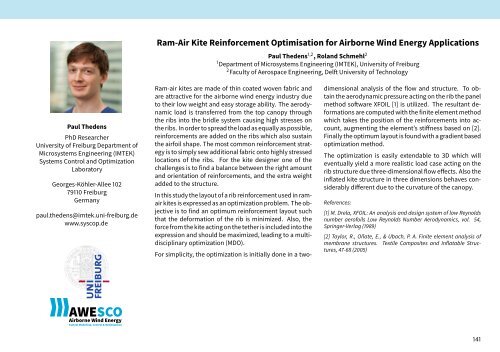Airborne Wind Energy Conference 2017 Book of Abstracts
You also want an ePaper? Increase the reach of your titles
YUMPU automatically turns print PDFs into web optimized ePapers that Google loves.
Ram-Air Kite Reinforcement Optimisation for <strong>Airborne</strong> <strong>Wind</strong> <strong>Energy</strong> Applications<br />
Paul Thedens 1,2 , Roland Schmehl 2<br />
1 Department <strong>of</strong> Microsystems Engineering (IMTEK), University <strong>of</strong> Freiburg<br />
2 Faculty <strong>of</strong> Aerospace Engineering, Delft University <strong>of</strong> Technology<br />
Paul Thedens<br />
PhD Researcher<br />
University <strong>of</strong> Freiburg Department <strong>of</strong><br />
Microsystems Engineering (IMTEK)<br />
Systems Control and Optimization<br />
Laboratory<br />
Georges-Köhler-Allee 102<br />
79110 Freiburg<br />
Germany<br />
paul.thedens@imtek.uni-freiburg.de<br />
www.syscop.de<br />
Ram-air kites are made <strong>of</strong> thin coated woven fabric and<br />
are attractive for the airborne wind energy industry due<br />
to their low weight and easy storage ability. The aerodynamic<br />
load is transferred from the top canopy through<br />
the ribs into the bridle system causing high stresses on<br />
the ribs. In order to spread the load as equally as possible,<br />
reinforcements are added on the ribs which also sustain<br />
the airfoil shape. The most common reinforcement strategy<br />
is to simply sew additional fabric onto highly stressed<br />
locations <strong>of</strong> the ribs. For the kite designer one <strong>of</strong> the<br />
challenges is to find a balance between the right amount<br />
and orientation <strong>of</strong> reinforcements, and the extra weight<br />
added to the structure.<br />
In this study the layout <strong>of</strong> a rib reinforcement used in ramair<br />
kites is expressed as an optimization problem. The objective<br />
is to find an optimum reinforcement layout such<br />
that the deformation <strong>of</strong> the rib is minimized. Also, the<br />
force from the kite acting on the tether is included into the<br />
expression and should be maximized, leading to a multidisciplinary<br />
optimization (MDO).<br />
For simplicity, the optimization is initially done in a twodimensional<br />
analysis <strong>of</strong> the flow and structure. To obtain<br />
the aerodynamic pressure acting on the rib the panel<br />
method s<strong>of</strong>tware XFOIL [1] is utilized. The resultant deformations<br />
are computed with the finite element method<br />
which takes the position <strong>of</strong> the reinforcements into account,<br />
augmenting the element’s stiffness based on [2].<br />
Finally the optimum layout is found with a gradient based<br />
optimization method.<br />
The optimization is easily extendable to 3D which will<br />
eventually yield a more realistic load case acting on the<br />
rib structure due three-dimensional flow effects. Also the<br />
inflated kite structure in three dimensions behaves considerably<br />
different due to the curvature <strong>of</strong> the canopy.<br />
References:<br />
[1] M. Drela, XFOIL: An analysis and design system <strong>of</strong> low Reynolds<br />
number aer<strong>of</strong>oils Low Reynolds Number Aerodynamics, vol. 54,<br />
Springer-Verlag (1989)<br />
[2] Taylor, R., Oñate, E., & Ubach, P. A. Finite element analysis <strong>of</strong><br />
membrane structures. Textile Composites and Inflatable Structures,<br />
47-68 (2005)<br />
141


